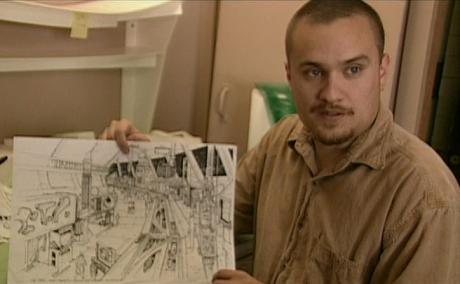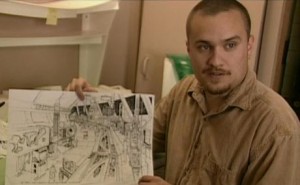
 Archival interview with Ricardo Delgado from the official Matrix website.
Archival interview with Ricardo Delgado from the official Matrix website.
MATRIX: Is your background in feature films?
RICARDO: I am a Conceptual Designer in film and I’m also a comic book artist. I have worked on films like Men In Black, Tomb Raider, Dinosaur and Atlantis, and have also done comic books: The Age of Reptiles and Hieroglyph. The brothers [Larry & Andy Wachowski] really like comic books, that’s sort of their background, so they try to get a comic book feel for their stories; that’s why I’m here.
MATRIX: You’ve seen the art generated for the first film, how would you say things have changed from what Steve Skroce, Tani Kunitake, Geof Darrow and the other guys did for the first film?
RICARDO: I thought that what they did was really cool and very ambitious, and now the thing is to build on that, it is a much larger vision now. Basically, they set all the ground work and we essentially have to take the ball and run with it. It is really neat to see a different vision coming out of the first film, and now my main concern is to keep the world consistent; to take what they did, have as much fun with it as we can, and tell a great story.
MATRIX: Would you say it is a bigger production this time around?
RICARDO: Absolutely. I wasn’t around for the first one, but this is a much greater effort with more storyboard artists. Everything is still centered around the brothers and Owen Paterson and Geof Darrow’s design work. It is really cool to see so many different styles of artists being applied to the same story, for instance, Steve Skroce has his own way of drawing specific things.
MATRIX: As an artist, do you naturally fall into a particular groove?
RICARDO: Yes, you kind of fall into a groove doing the thing that you like doing. What I am working on right now is interesting to me, it’s really kinetic and there’s a lot happening story-wise as well. Innately you do well what you like doing, and the brothers are really good at picking up on that and sort of sensing that this guy does this really well and that guy does that really well, so let’s keep them going on with what they’re doing.
MATRIX: Over the period of time you’ll be working here, do you foresee that your style will change?
RICARDO: Yes, it does. On every show you start out working one way and you end working in another way. Ideally you want to make the boards consistent, but there’s a familiarity with the designs to take into account. For example, you’re given a ship to draw as part of a storyboard, let’s say the Nebuchadnezzar, I saw the film but I don’t know the shape of the ship that well. As pre-production goes on and I draw it more, I become more familiar with it, the familiarity comes into play, showing in my illustrations.
MATRIX: How much interaction do you have with Larry and Andy?
RICARDO: They come around the Art Department, they’re really casual in that way. They’re different from other directors in the sense that they’re very approachable, you can see them and ask them about things, a lot of other guys aren’t like that. They appreciate and like the same things you like, not just comic books, but movies as well – we like the same monster movies, we like the same kung fu movies, we like the same comic books; so essentially it is really interesting and great to work with people instead of working for someone. You definitely feel like you’re working with them and they really appreciate what you’re doing; that is what separates them from other guys.
MATRIX: Currently, how many artists would you say are working on the project?
RICARDO: At a rough estimate, about a dozen at the moment. Again, that is the great thing about this, we all have different styles and we’re all trying to mesh these different styles into one cohesive vision, we all bring our different areas of interest and expertise to the project. It is interesting to see how we inspire each other as well, looking at other artists’ work in the next cubicle over.
MATRIX: Taking another visual effects heavy film like Men In Black, how does the Art Department here compare?
RICARDO: Men In Black was both the same and different simultaneously. I was on very early in that film and did a lot of design work, leaving before the production actually started. So this is similar in the sense that we’re working really early and developing ideas, even though we’re supposedly making a movie in about six months or so, and I’ll be leaving the show before the filming starts. That’s sort of the role of the illustrator in film, you work on a film and a couple of years later, or a year later you see this thing on the screen, and that’s always really interesting, sometimes to your enjoyment and sometimes not.
This is definitely the biggest film I’ve ever worked on. Dinosaur was a big prep, but this is a big prep on a story that is cohesive and very well thought out, yet it is still a gargantuan story which needs to be designed and told.
MATRIX: How are the required shots from each scene made clear to you?
RICARDO: It mostly comes through Larry and Andy, and sometimes Owen [Paterson, Production Designer]. Let’s say something happens in a subway, like at the end of the first film, you as a storyboard artist should check with your Production Designer because he probably has plans, or a location has been found, or he’s going to have a set built. For you to execute storyboards that have no bearing on what the Production Designer is doing is sort of useless. It’s more efficient and works out much better if you take everyone else’s feedback and then go away and tell your own little story, your own little slice of THE MATRIX.
I try to have as little of myself on this project and as much of the Wachowskis’, Geof’s, and Owen’s design work as possible. When I’m drawing a storyboard and there’s a set, whether it be a subway or a castle or whatever, I check with Owen because he has put a great deal of effort into coming up with a solution to the problem, I want to make sure his thoughts and his interpretation of what we want to do are there as well. I would much rather see what Owen does and what Geof does represented in the film and be able to enjoy it on that level. To me, a storyboard artist is more a storyteller than an actual designer. I’ve done a lot of design work for other films, but it’s really neat to design this story, visually interpreting the different levels of the MATRIX world, and I enjoy applying what we’ve all done to this story.
MATRIX: There are so many artists here, how do Larry and Andy convey to you in particular exactly what they want?
RICARDO: They have notebooks they carry around which have small thumbnail sketches, or a rough drawing of what the shot is. They tell you this is a shot of the Nebuchadnezzar landing in a sewer, your job after that is to not only draw the Nebuchadnezzar, but to decide if it is coming down this way or that way, what kind of a sewer it is, whether it is heavy piping, old piping or rusty piping. So there’s a lot of thought that goes into that as well, and you decide whether it comes down at an angle or not. Larry and Andy are usually interested in what is cool, and essentially that is what separates them from other directors; they know what’s cool, they like what’s cool, and they want to do that.
MATRIX: Were you excited upon reading the scripts for THE MATRIX 2 and 3?
RICARDO: Absolutely, they are very ambitious, and that’s a tough thing, ironically enough, to find in Hollywood: a lot of fresh new ideas, and that’s what these guys really bring to the table, they’re interested solely in a great product and telling an interesting story. You read the second script and you go, “Wow! That’s really cool,” then you read the third and you’re like, “My God! This thing is huge!”
MATRIX: Taking a step back, you saw the first film not knowing you would be involved in the future…
RICARDO: Absolutely. You know what’s really funny, there’s a story behind that: my wife wanted to see the movie and I had no idea what the film was about. I just saw this poster with the three guys standing there, and she said she’d heard it was really good, and I’m like, “Oh really? I don’t know, you don’t know too much about it.” And she said “Let’s go see it.” When you don’t expect or know anything about a story, and you come in and it kind of floors you like that, watching the film for the first time and seeing the reveal of what the MATRIX world actually is, the real world, seeing the Doc Bot and the Harvesters and all that, it was a real treat. And now, a couple of years later to be working on it is really cool. It doesn’t get better than that.
MATRIX: Thanks Ricardo.
Interview by REDPILL
November 2000

Be the first to comment